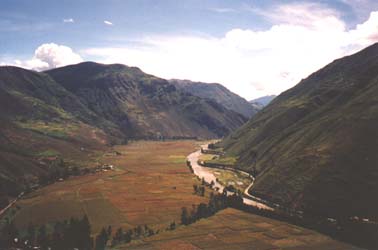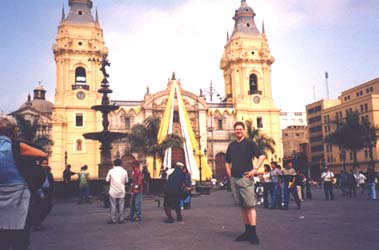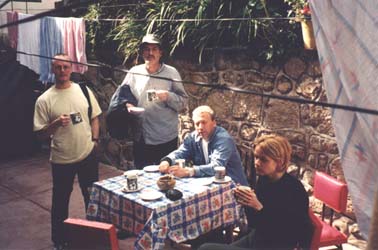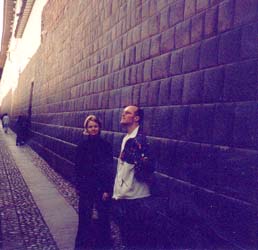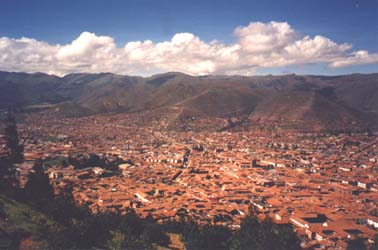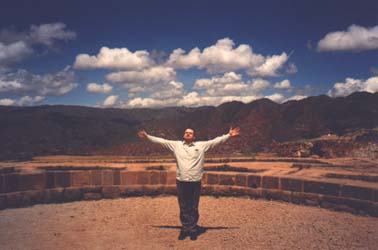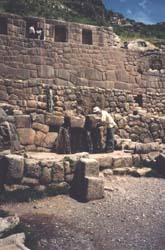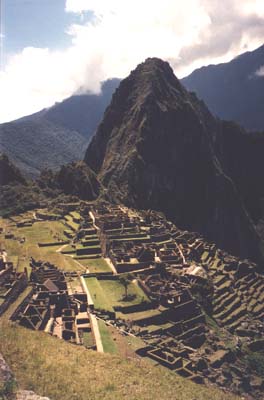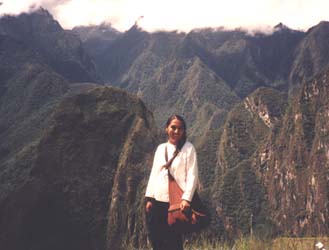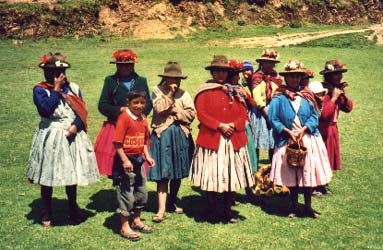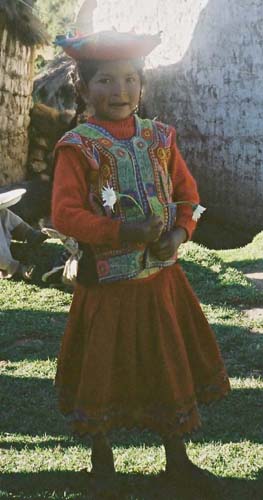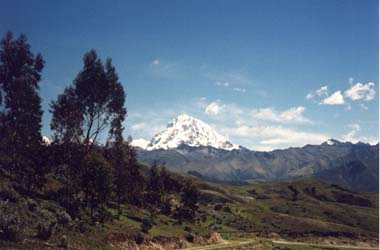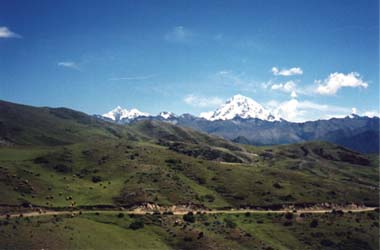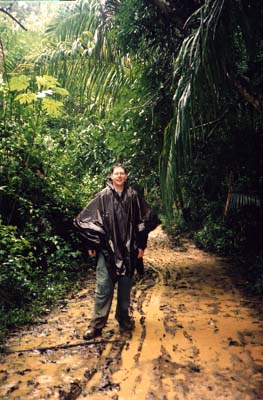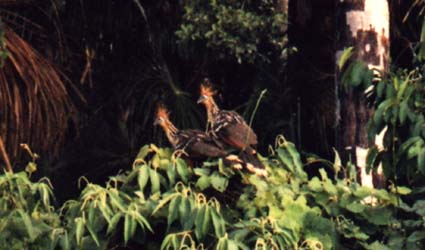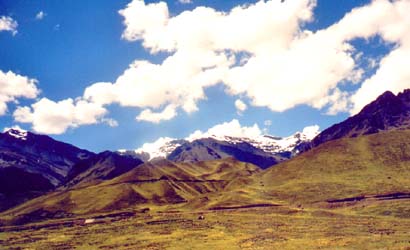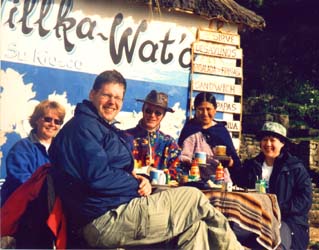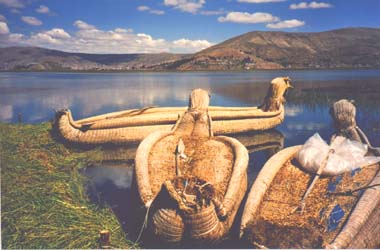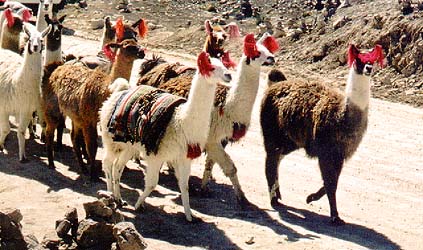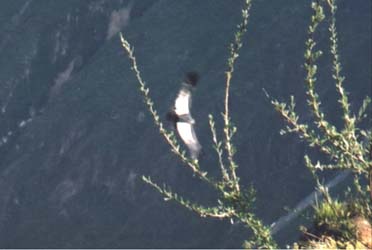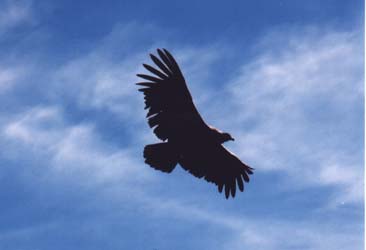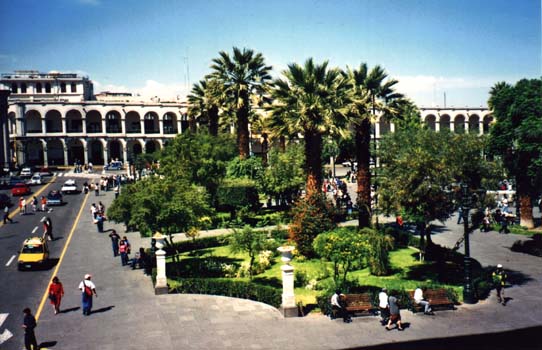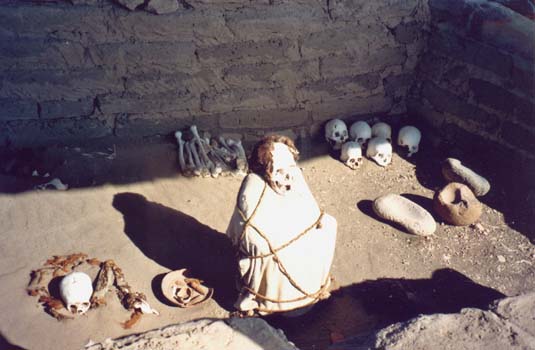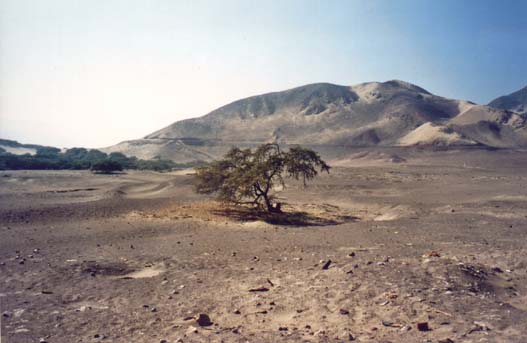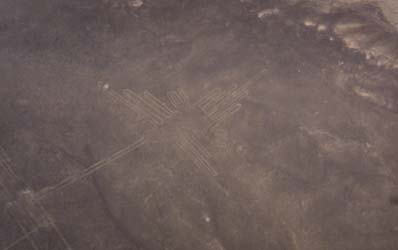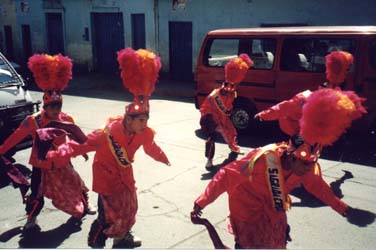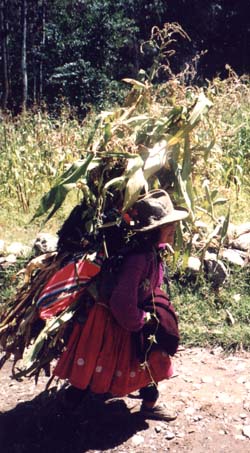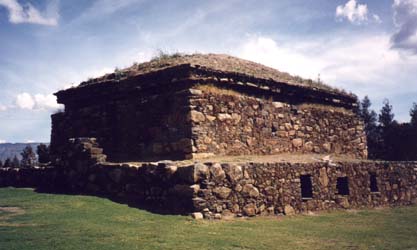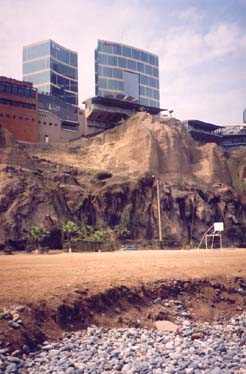PeruThis page tells you about my travel in Peru and my experience of the country. Perhaps you can find some inspiration for a journey of your own!
LimaMy next big trip was with an old collegue from SAB WABCO, Göran. We called me at work one day: "What do you say, do you cant to come along on a trip somewhere for a month or so?". What could I say? Of course I would! After some planning, we decided to travel with "Läs&Res", a swedish travel agency, to Peru. Now Peru is a country that I can really recommed. If you are only interested in beaches and nightclubs it may not be your ideal destination, but if you can appriciate the beautiful nature, lots of interesting history and old cultures, meeting people with a totally different cultural background and so on, this is the place where you must go!!! We flew to Lima from Copenhagen via Amsterdam in the middle of April 2001. In Amsterdam we met those in the group coming from Stockholm, Gothenborg and other places. After a long, long flight we finlly arrived in Lima in the evening. We took a couple of mini-busses from the airpoirt, where we met our travel leader Carmen Blanco, to the hotel through some of the poor areas of the city. We could see that we had come to a different world... The next day we wanted to do two things - start to learn about Peru and go sightseeing in Lima. The first of these objectives we tried to meet by visiting the Museo de la Nación. In the west most of us only know about the Inca culture, but it was impressive to see the number of cultures that lived in western south america long before the incas. Sightseeing Lima could take you to many places, but we only had one day in Lima so we took the bus to the city centre and started walking around.
Placa Mayor above is the citys central square and is also the heart of the colonial Lima. From there the main tourist street extends down towards the Placa Bolognesi, but be sure to check out the smaller streets as well! Maybe go into a restaurant and have some ceviche! Lima has many interesting things to see, but for me it was only a step on the way towards the real Peru. The next day we went to the airport and, after a long delay, flew on to the old Inca capital - Cuzco! CuzcoWhen arriving to Cuzco, one could immediatly feel a different atmosphere in the air. It wasnt just the indian band playing andean music in the airport arraval hall, it was something more. Cuzco is located in the Andes at 3330 metres above sea level, and if you like me fly up from Lima you will notice being short of breath. This will pass, just take it easy and do not overexert yourself walkng trying to see the hole town in one day. Some coca-tea will also help. And to answer one of the most common questions, it doesnt give any narcotic effects! When you first arrive in Peru you should be careful about what and where
you eat, so that you give your stomach a chance to adjust itself to the
different bacteria flora. I didn't. At the first night in Cusco, we went to
a small restaurant where the peruvians themselves eat. Later that night, I
got a feaver and I was shaking and shaking. Not to mention running to the
bathroom all of the time. I finally put on all clothes, including my jacket,
crawled into my sleeping bag and put 3 thick blankets on top. I was freezing
and shaking my teeth so much that Göran said he couldnt sleep...
The next day the Carmen rented a minibus with a guide, and we went to see some of the most important ruins around Cuzco. I had recovered sufficiently so that I could come along - but it was a close call. I didn´t decide until 5 minutes before the bus would leave...
We visited Sacsayhuamán - an Inca temple and/or fortress, Qenko - a ceremonial center dedicated to the worship of Pacha Mama (mother earth) and Tambomachay - a bathing place for the ruling inca class which has a holy spring supposed to make you fertile.if you drink the water.
Carmen, who was born in Peru and had been on similar tours around Cuzco before, instructed the guide not to rush things the way it is often done when guiding tourists (no matter where in the world you are). That was a good decision, since we could enjoy the places we visited. In the afternoon we headed towards Urubamba - the sacred valley of the incas. Its sacredness was nothing mysterious, it was just such fertile land that it must be seen as sacred. In Urubamba is Pisac, a small village with a well known market. Be prepared that there will be a lot of tourists nowadays. Still I enjoyed the visit, even though we didn´t have the energy to see the inca ruins above the village.
If you take two days instead, there are lots of other places to go to as well in Urubamba. Back in Cuzco, you can walk slowly through the city and look at the locally produced handicraft for which the inca descendents are known. A lot of indian women and children will approach you and try to sell their handicrafts, post cards or other items, but do not fear - the people of Cuzco always treat you with a friendly spirit. Our hotel, hostel Pakcha Real, was situated in San Blas, an old area of Cuzco within walking distance from the city centre. It was a family hotel and very charming. Machu PicchuWhen in Peru it is impossible to ignore Machu Picchu. The ruins of this old inca city lies in spectacular surroundings on top of a mountain top, with other mountains reaching for the sky next to it. When Hiram Bingham rediscovered Machu Picchu in 1911 he actually found an indian famility living among the ruins, so the place was not completly unknown. Since it was never found by the Spaniards when they concurred the country, the ruins are very well preserved. It is believed that the reason the Spaniards never found Machu Piccu is that it was already deserted. The question why, as well as the question why Machu Picchu was built in the first place, is still unanswered. This is not only a place to go for those interested in history and archeology. The ruins in combination with the sceanery makes this a must for everyone! One can also climb the mountain top overlooking the ruins, Huayna Picchu.
There are two major alternatives on how to get to Machu Picchu. One is to take the train from Cusco. It arrives in the small village of Aguas Calientes at the foot of the mountain. From there you can either walk to the ruins (but it is a long climb) or take the bus. The train used to be a simple local train, but it has now been replaced by a tourist train, something that not everyone finds to be a step forward. The second alternative is the one that has the largest potential for
providing a mighty experience. It is the inca trail, which once was used by
the incas as the connection between Machu Picchu and their capital, Cuzco. During our trip we unfortunatly didn't have the time to walk the inca trail. Instread we took the train. Machu Picchu is indeed a magnificant place, and I can recommend everyone to go there. The downside of taking the train was that we only had about 3 hours at Machu Picchu, and that is not nearly sufficient.
Visit to an indian village in the AndesFor the next four days, we were to get to see what most tourists completely miss out on. Thanks to the connections of our travel leader Carmen and her father, we had the oppertunity to live in a poor village in the Andes and to get to know the people living there. The evening before going there we met one representative from the village at our hotel in Cuzco. He seemed very nice, but still I didnt know what to expect. He told us that the people in the village were quite isolated, and having people from the other side of the world was a big event for them. The next morning we loaded our luggage onto the roof of a mini bus and ourselves into the same. After a couple of hours, the bus turned into a small gravel road. Well, hardly a road - more like a trail. The road went upwards most of the time, sometimes with a steep descent on one side. We really prayed that the driver had his attention on driving... We started passing people of indian origin, who worked om the fields. Most of these fields are generally considered as not possible to grow crops on since they are too steep. That didnt seem to be a concern to the indian farmers, who had never heard of such rules... After having passed a top at 5000 meters, the track started to descend again, and soon we were at the village. The villagers had built a portal from branches and leaves and decorated it with flowers, all in order to greet us! As we stepped out of the bus, the whole population of the villages was there, looking, greating us and throwing above our heads. It was a reception so warm that you just couldnt resist feeling touched.
During our whole stay the people in the village continued to show us their hospitality. On of the purposes of the visit was to see how people live in andean villages however, and the best way to learn is to live it. Although we didn't sleep in their cottages, we did live under very basic conditions. The food consisted mainly of potatoes, possibly with some cheese, potatoe soup and some more potatoes. In the evening the local band played their music, and everyone danced. Now dancing can be very exausting at 4000 m! One day we helped (at least we tried) working in the fields. Using a foot plough can be hard work!
The days we spent in the village were very tough both physically and mentally, living in such simple conditions, but considering was we got it was certainly all worth it. We learned to know a people that, although very poor, had a large amount of pride and dignity. They also struck me as being very happy and full of life. As they also did everything they could in order to make us feel welcome, it was not hard to really like them. The time in the village will be a memory for life. The final day, before we had to leave, all villagers again gathered. They thanked us for coming, and we in turn tried our best to express out gratitude over the truly wonderful way that they received us. After having danced through the portal, we finally entered the bus and drove away. On the way from the village, the bus got two flat tyres. The bus being heavily loaded that was no surprise. We had to walk part of trail, but considering the astounding beauty of the surrounding nature, we didn't mind!
The bus had to stop in a small town in order to repair the tyres. We went to the local marked and then waited for the bus to return. The large crowd that gathered around us, most of whom had probably never seen a white man before, was yet another unusual but not unpleasent expecience... Rainforest near Puerto MaldonadoAfter the visit to the indian village, we went back to the same hotel in Cuzco for a night before leaving for the next event: four days in the rain forest near Puerto Maldonado in south-eastern Peru. We went up early in order to get to the airport. While we waited we played some cards ("gurka" - that was to be regular event on our trip, thanks to Lennart). Carmen had contacted InkaNatura and arranged a stay at the Lake Sandoval
lodge. Two guides from the lodge met us at the aiport. In order to get to
the lodge we had to take a minibus to Puerto Maldonado (where we spent a
couple of minutes in order to find some rain poncho - the rain season was
just ending, but hadn't lost its grip just yet... From Puerto Maldonado we went by boat along the river for some time before starting a little walk... The next step was a 3 km walk on a jungle trail in order to get to the lake Sandoval. The only problem was that the trail was all mud (No that's not true. The trail was mostly water with some mud added to the mix. Nice!). Luckily we had been warned when arranging the trip in Cuzco, so most of the people in the group had gotten rubber boots. One thing though is that in Peru it is impossible to get boots above size 43 (european size), so I and a couple of others had to make do with what we had. Thank God that I had decided to get those hiking boots with Goretex... While we made our way along the trail - with me stepping real careful so that I didnt step into a hole with water deeper than the hight of my hiking boots - the rain continued to fall. At the end of the trail waited two canoes with which we got through a swamp and across the lake Sandoval to the lodge. The lodge turned out to be very nice with hot water in the showers (such luxery!!!) and a comfortable bed. They served two 3 course meal each day as well, so we didn't starve. It turned out to be a perfect way to regain ones strength after the hard stay in the indian village. The exploration of the rain forest was a bit of a disappointment though. Although there was a small system of trails around the lodge, most of the time was spent on the lake. Sure we saw some interesting birds and a couple of baby cajmans and almost could see some monkeys that the guides tried to show us, but I didn't get that djungle feeling.
The last day we had to get out of bed at 4 am in order to use the canoes, walk the trail (still as muddy!) take the boat and finally the mini bus to the airport and catch the plane on time. When we got back to Cuzco we took in to the same hotel for a last night in Cuzco before continuing south towards the lake Titicaca. It was a little sad, since that hotel in Cuzco had almost become like home to us! Lake TiticacaTravelling between Cuzco and lake Titicaca you have two main alternatives, the train or the bus. The bus is a bit faster and cheaper while the train will give you a better chance of enjoying the trip. Our group chose the train, in my opinion the right thing to do. We went to a train station early and had then 12 hours of train travel in front of us.The view from the train was absolutely wonderful, with the mountains and the Altiplano and the occational small villages. You can't spend all the time looking out the window though, so some of use used once again a deck of cards and played "gurka". Having meals and some candy and maybe some liquor also helped to pass the time - the local rum is actually quite good!
At one time the train stopped very abruptly in the middle of the plain. Eventually we found out that it had hit an old woman. Luckily she was not badly hurt, and the train could continue towards the south. Once in Puno it turned out that someone had forgotten the keys to the luggage compartment in Cuzco. There were a lot of unhappy travellers until the padlock could be cut and everyone could get their belongings... We went to a hotel in Puno, the hostal Margarita. It is a hotel that I can recommend. The standard is ok, everything works and the owners are extremely helpful and can help you to arrange trips wherever you want to go. As we were a couple of days before schedule, we decided to go on a little detour into Bolivia, to Cobacabana and the Isla del Sol. The next day we took the bus to Cobacabana. Immediatly when you crossed the border (after having had stamps in your passport from both the Peruvian and the Bolivian authorities) you noticed that the road was much worse. That was just one of many signs that although Peru is not a wealthy country (counted in money), Bolivia is much poorer. After a small lunch we rented a boat and driver to take us to the Isla del Sol. It took a little while, because I don't think that the engine speed was above idle at any time... That evening we went for a long walk around part of the island, and then slept in very basic rooms in a village. Luckily I had brought my Thermarest, so I could sleep quite well! The next morning, the boat came to pick us up, and we went to another part of the island where some in the group went looking for some ruins. I didn't. Instead me, Göran, Elisabeth and Sabina stayed, had a good breakfast and took it easy (below left). That was nice! If you go to the Isla del Sol, you should probably see the Temple of the Sun. We didn't, because we didn't know where it was...
As we took the bus back to Puno, lots of backpackers were trying to come along. It turned out that they were leaving Bolivia because the next day a huge strike was supposed to block all activity in the country. That strike was a result of a government decision to, after from the USA, ban all growing of Coca plants. Read my comment on the use of Coca here. Back in Puno in Peru, the next thing on the schedule was to go to the Amanti island on an overnight trip. Some of us however thought that we would rather stay in Puno and regain our stength, since a busy schedule lay ahead. We instead took a half-day trip to the Islas del los Uros, the reed islands. Originally build by a people being pushed out of Bolivia, these floating islands have survived the recent years with the help of tourists. That was ok, and the trip there was a very interesting one. Puno was a town that I didnt have any big expectations on, but I found it to be a very nice place. On the main street you are likely to run into lots of backpackers (one of which turned out to be from my home town in Sweden - it's a small world!) but if you explore the rest of the city you can see what a real peruvian town on the Altiplano looks like. You could visit the huge market (or markets) and be the only "gringo" (white person) in sight. Even in the market selling crafts we where the only tourists. I really recommend that you do not just use Puno as a base you your trips. Instead, be sure to take time to explore this town. Arequipa and Colca CanyonTo Arequipa and away towards the Colca CanyonWe left Puno after lunch the 3rd of May, in order to fly to Arequipa. Arequipa is the second largest city in Peru and is the most independent one. It is situated in the south of Peru, at 2400 meters above sea level and has 360 days of sunshine per year! As we approached Arequipa, we noticed how the landscape below us changed. It was now all volcanic material which made up a grey, gloomy view like nothing I have ever seen before. Arequipa is located right beneath some volcanos, of which El Misti is the most prominent one with its 5800 m high top. It is a mighty sight! Arequipa was originally an Inca city, but it was taken over by the Spaniards and still have a lot of colonial houses. However, on this first visit to Arequipa we were moving on fast. Already the next morning we sat in yet another of these mini busses that are present everywhere. We were heading towards the Colca Canyon, which is a canyon twice as deep as the Grand Canyon in the USA. It has a long history being used for farming, and there we would see lots of inca terracing. The way there,a 4 hour drive, was something to talk about. The first part of the road is a big, modern road. Then it begins. A gravel road which just keeps getting rougher and rougher. The mini-bus, a Nissan, didn't help since it didn't seem it had any suspension at all... We stopped twice. Once at 5000 meters, where the volvanic landscape was an especially stange view, with snow white mountain tops in the background. That was also a place which was used for worshipping the Pacha Mama by building small (less then 50cm high) towers from small pieces of rock. The place was completly full of them. It was really a strange sight! Some llamas also happened to walk by here.
The second stop was caused by the sight of a rare animal: the vicuña. It is the smallest member of the llama family and has been threatened by extinsion but is now slowly recovering. It is quite small and very and almost looks a little lika a deer. Yet it was not the animal that would make the largest impression on this trip to the Colca. Arriving in the Colca Valley we went to Chivay, a little town, where we would stay for the night. We went for a long walk, first to a watch tower and then to a the Baños Termales (hot springs) of La Calera where we enjoyed a relaxing bath in the water from the hot springs. The evening ended with good food at a local restaurant where they also showed the local dance traditions. The next morning we had to get up at 5 am and sit in the bus for another couple of hours of rough gravel road going further into the valley towards the real canyon. Why? Because this was our chance to see a remarkable bird close-up: The Colca Canyon is one of the few places where you can regularly se the condor!
In the mornings, the condors will leave their nests deep down into the canyon and ride the warm up-winds created by the sun in order to start the days hunt for food. They are particulary common at the Cruz del Condor viewpoint, where we waited in order to see these majestic birds. Just before 9 am, when I had almost started to loose hope, we say a first glimpse deep down below us. It was two condors, and they were slowly ascending towards us. Then more condors came into sight, and a couple of hours later we had seen as many as 35 to 40 condors, some as close as a couple of meters! The slow flight of these big birds was certainly a memorable sight! The day ended with a long ride in the bus back towards Arequipa. Still with no noticable suspension on these rough gavel roads made the ride less than comfortable. Still one should not complain. After all, it is all part of the total grand expericence! ArequipaArequipa is a very beautiful city, with lots of colonial houses. The most beautiful place is probably the Placa de Armas in the city centre. One thing that struck me as odd was the large number of old american cars from the 50s and 60s. I guess that with the dry and sunny climate, there is not much a rust problem. Arequipa is situated in a very active area with active volcanoes nearby and is shaken by several earthquakes each day. Most of these are too small to notice however, and are only known from the seismological measurements. One one side of the Placa de Armas is the cathedral. It has been destroyed by earthquakes several times through the centuries. One of its towers was destroyed in the earthquake in 2001, just a month or so after we got home. However, do not let this frighten you into not going here, since it is a place which is well worth seing.
One of the most interesting places in Arequipa is the old convent "Monasterio de Santa Catalina". It was opened up in 1970 after 400 years as a cloister when it was closed to the surrounding city. It was in itself a city within the city and was the home of thousands of nunns and servants. I recommend that you use one of the current nunns as a guide. In this way the old cloister really comes alive! NascaThe next planned stop after Arequipa was in Lima on the way to Huaraz, but we didn't want to miss Nazca. Nazca is situated in the desert between the sea and the Andes in the southern part of Peru. It was the centre of the Nazca-culture which flourished some time 300BC-400AD and are mostly known for two things: their pottery and the Nazca lines. The Nazca lines are great lines and images scetched in the desert. There are many questions about them, like why were they made - and how? Theories range from aliens to the lines being an astronomical calendar. The images can only be seen when flying, which raises another question: could the Nazca people somehow fly? In order to fit Nazca into our schedule we took a night bus from Arequipa towards Nazca. It had very good standard, but as I have problems sleeping when I'm not in a bed, that didn't help that much.
When we arrived in Nazca earely in the morning we had some breakfast in a hotel, and then arranged the flight over the lines. Since the weather wouldn't clear up until noon they recommended us to go to the Chauchilla cementery first. Chauchilla is an old burial site a few kilometres outside of modern Nazca. It used to be a place where grave-robbers struck and where bones were scattered around the desert, but the authorities now have taken charge and cleaned up the site. There are many graves where you can see mumies in the enviromnent where they where buried. We had a very good local guide, which also told us about the cultures of the desert. If you go to Nazca, don't skip Chauchilla. For me, it was almost more interesting than the Nazca lines!
When flying over the Nazca lines they take you up in small planes like Cessnas or Pipers. They turn alot in order to let you see the images as well as possible. That also has the effect that it is not difficult to get nausea. I recomment that you do not try to take pictures, as it it makes things worse. That said, it is a mighty sight seeing these huge images. Huaraz and the Cordillera BlancaFrom Nazca we took the bus to Lima, were we spent the night. Then we took another bus towards Huaraz, a town north of Lima situated in the Cordillera Blanca. This mountain range is is very popular among mountaineers and trekkers and many treks, most 3-5 day ones, exist in the area. One the bus one strange thing occurred. First we saw that at one point two men jumped onto the bus, and a little while later jumped off and run away. Then the bus was stopped by the police who asked the driver something, but the bus then continued. About 15 minutes later, the bus was again stopped by several police cars and was searched by police men armed with automatic weapons. We found out that there had been an armed robbery in the area and the police were looking for 2 men. Propably the very ones that had jumped onto the bus! Anyway, we were allowed to continue once again, and after a total of 7 hours from Lima we arrived in Huaraz.
Huaraz is in itself not a very exciting place. If you go here, you should do it for the climbing or trekking. It is also possible to go to Chavin de Huantar, and important place of the Chavin culture. It is regarded as one of the first high civilisations in Peru. The ruins of the temple in Chavin de Huantar were central for this civilisation and can be visited on a day trip from Huaraz. Be prepared for lots of bad roads... During our stay in Huaraz, a local festival was staged and lots of dance groups like the one on the picture were seen all over town.
For me, Huaraz was not so important or exciting compared to the other parts of the trip. You probably have to go on longer treks in order to find it worthwhile. None in our group did that however had that kind of energy left this late during the travel. Back in Lima and Miraflores
RecommendationsAs you may have understood, I really found the trip to Peru worthwhile. We were away for a month, and I would recommend that you take at least that time to get to know the country. If you don't have the possibility to do that, do not try to see as much in a shorter time. Choose what you are the most interested in and give it the time it deserves. Cuzco and its surroundings, Urubamba and Machu Picchu, can not be ignored. They are a must. The most interesting part of the trip, living in a small village in the Andes, can be hard to arrange by yourself. Colca Canyon with its condors, Arequipa and Nazca I also recommend. Huaraz was not that important to me, but if you like trekking it may be a good choice for you. The Islas los Uros and Puno should not be missed if you have the time. We went with swedich travel agency Läs&Res, and I can recommend their group travel. You won't get any luxury, but you will learn more about the country and its people than most other forms of travel. If you like, it is possible to leave the group and do your own thing. Carmen, our travel leader, did a good job as well. If you have any questions, you are welcome to contact me at publicinfo@staffannilsson.eu. I am only a tourist so I may not be able to answer your question, but I can always give it a try.
All text and pictures Copyright Staffan Nilsson 1995-2002 Contact me at publicinfo@staffannilsson.eu This page has had
|
|||||||||||||||||||
